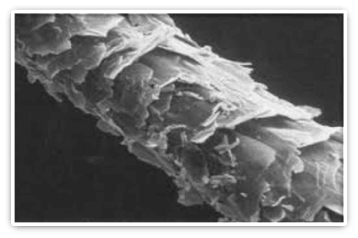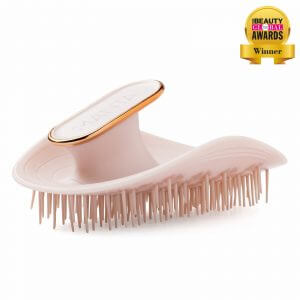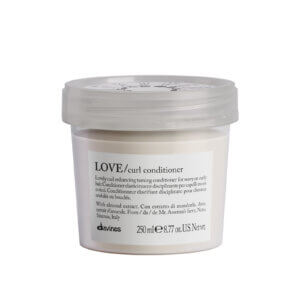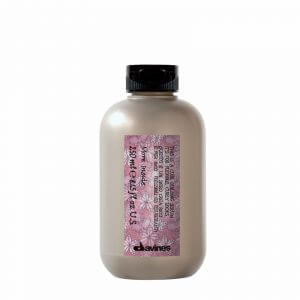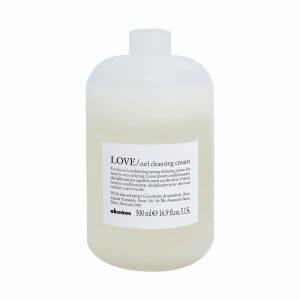
Caring for Curly Hair
Here is our in-depth guide for how to care for curly hair; from wavy hair (type 2) through to tight coily hair (type 4c). We will endeavour to educate and explain so that you have enough knowledge to look after your hair to achieve and maintain the style you want.
Knowing how to care for your hair is just as important as having a great stylist. Getting the right advice from an expert stylist can make a huge difference and so we have taken our expertise to create this guide for everyone. Whilst we cannot give you a personal consultation via our website we can give you some of the knowledge required to match product choice to your hair texture.
A big challenge with so many hair care products available is knowing what product will meet your needs…
Kate
We are a leading curly hair salon in Brighton – We love hair of all textures, colours and density and we specialise in all of them!
What is a co-wash?
A co-wash is simply ‘washing’ your hair with no shampoo and only using conditioner.
Why do you need to do this? Curls & coils need a lot of moisture, so we advise to fully saturate your type 3 curls or type 4 coils in the shower with water at least every other or every third day. You would not want to shampoo or cleanse your curls and coils this regularly, far from it. You could go up to 10 days between cleanse days or wash days. (I appreciate this isn’t a hard rule for everyone, you know your hair and what it needs in terms of shampooing)
When saturating your hair, curly girl method advises that you add more moisture to your hair, not just with water, but in the form of a conditioner or a conditioning mask. This will give the moisture boost you need, without striping the scalp and hair of its natural oils with a shampoo. This is co-washing.
A co-wash product is perfect for when you need to wash your hair in-between wash days
There are heavily conditioning and very gentle shampoos available called co-washes, these are different to what used to be known as two-in-one’s. We recommend Davines’s Love range, curl co-wash.
A co-wash product is perfect for when you need to wash your hair in-between wash days because you have done a lot of exercise or for any other reason.
You can use your regular conditioner and just miss out the shampooing step.
It is really important to give curls and coils lots of moisture. If your hair is frizzy, it is thirsty! Give it water! It is as simple as that. It can take time to evolve a frizzy wave to a hydrated healthy-looking curl, even a year or more. But it is worth persisting and the stepping stone to achieving this is co-washing.
If your hair is frizzy, it is thirsty! Give it water!
How often should I wash my hair?
Wash day frequency is something that us curlies think about quite a lot! So how often should you wash your hair? Well there is no hard & fast rule that gives the answer to all Hair types. The answer is clearly dependant on your hair & your lifestyle.
If you swim a lot, exercise a lot, have massages (with oils on your scalp) for example you will need to cleanse your hair after these activities. If these activities are regular you need to ensure you are using a gentle cleansing shampoo Eleven Gentle Cleanse & K18 maintenance shampoo are two really good ones.
Solely based on the hair type, Type 2 (wavy hair) should cleanse every 2 – 5 days. Type 3 (curly hair) should cleanse every 3 – 6 days & Type 4 (coily) hair should cleanse every 5 – 10 days.
Curls & coils need moisture. Using too harsh a shampoo could remove your hairs natural moisture so always ensure you’re using a sulphate free shampoo.
With type 2 & 3 hair, the lower number is for hair that is on the oily side & higher number for naturally drier hair. All type 4 hair is naturally drier so the number is based on how much product you use (you may need to cleanse more regularly to refresh your style routine) & how your scalp feels, you may like the feel of cleansing your hair more regularly. The porosity of your hair is another factor to consider….
Curls & coils need moisture. Using too harsh a shampoo could remove your hairs natural moisture so always ensure you’re using a sulphate free shampoo.
Once you’ve found your favourite sulphate free range, such as Eleven Australia or Authentic beauty Concept then select the correct concern for you. This may be volume, moisture, repair (protein), smoothing or colour maintenance. Follow our porosity guide to see if you need moisture or protein.
More important than how often you should wash your hair is how often you should wet your hair which we will discuss below.
Washing curly hair
When washing your curls, apply the shampoo to your palms and rub together, apply to your scalp and gently massage all over your scalp. This massage wants to be a gentle circular movement called effleurage. You don’t want to create tangles with a vigorous motion, it is gentle, continuous movement to lift away any sweat, dirt or product build-up.
If you are not getting a lather you need to add more water, not more product. If it has been a number days between washes (which is advised) you may need to repeat, with a second wash. To cleanse the rest of the hair, mid-lengths and ends, simply pull the shampoo down the hair with a stroking movement, not a rubbing motion, again we are avoiding creating tangles.
Once your hair is clean, squeeze out as much moisture as you can, you may wish to gently towel dry and then apply your conditioner or mask, from ears down (avoiding the root area) then detangle and evenly distribute the conditioner using a manta brush.
If you are not getting a lather you need to add more water, not more product.
For thick type 4 hair, you can do a quick rinse, leaving some product still in the hair to enhance moisture levels. To gently remove excess water wrap your hair in a microfibre towel or a cotton t-shirt (this will prevent frizz). Cotton towels tend to cause more frizz whereas a microfibre towel or cotton t-shirt don’t as they don’t have the rough grooves found in cotton towels.
Once out of the shower apply your leave-in conditioner first and for type 3 and type 4 hair you can use a manta brush again to remove tangles. For type 2 wavy hair or hair that is not tangly there is no need to brush again. Just brush in the shower, with conditioner in.
A spray leave-in conditioner is generally slightly lighter than a cream leave-in conditioner. Sprays for generally better matched for finer hair and creams for thicker hair.
Once you have applied your leave-in conditioner you will need to add more moisture to ensure definition and to remove frizz, do this using a spritz water bottle (easier than a spray water bottle).
To gently remove excess water wrap your hair in a microfibre towel or a cotton t-shirt (this will prevent frizz)
You could add a little leave-in conditioner to your water spritz, for a diluted extra boost of moisture. Then, on your very wet hair, you are ready to apply your chosen styling mousse, gel or cream.
How do I get moisture into my hair?
Water, water and more water! We recommend that you completely soak your hair in water every couple of days to rehydrate it. This is particularly effective for type 4 coily hair. Depending on what suits you this can either be in the shower or using a water spritz (these are easier to use than a spray that you need to keep pumping).
If rehydrating in the shower bear in mind that you will wash away any products so you should always condition and reapply any products you use and style as normal. Using a water spritz whilst getting you hair wet shouldn’t wash away your products so is usually a quicker option.
I hear from my clients, that it is a common thought that water is bad for curls as it is associated with making curls frizzy. This is because your hair will search out moisture. So on a damp or humid day, your hairs cuticles will raise to allow moisture to penetrate the hair. If your hair already has enough moisture it will not try and find more.
Kate
With this routine you are totally soaking the hair. Curly & coily hair is thirsty hair and your hair will tell you now much water it needs. Even if you are fresh out the shower, I still advise to spritz more water into your hair, as it drips, that’s telling you it has had enough to drink.
The more moisture you have, the better the result, with less frizz.
Applying product & styling curly hair
Mousse will encourage a curl or wave, so is best for type 2 or 3 hair. It should be used to define curl and generally add volume, especially if used with heat (diffuser).
A curl cream will generally define a curl and even tame a curl, so is great for type 3 and 4.
Gels are good for giving control and more hold which can be great for type 4 coils. They are also good for adding shine and a bit of moisture.
If you find a gel too heavy, for type 3 curls, you can cocktail a cream and a gel together. Apply to your palms and mix together before applying section by section to your hair.
When applying your products to medium or fine type 2 or 3 hair, you can apply to your hair without needing to section the hair, rub with product in your hand and scrunch through your hair, you can apply with praying hands and then scrunch. You should be able to hear a squelch with the amount if product and water in your hair.
Curls should never sit flat to your head, you have natural volume so embrace it!
To give real definition you should twizzle the hair (sometimes called shingling) to separate the curl and give definition from root to tip. This is with the product in your hair, with your hair being very wet. Take small sections of hair and twist around your finger and then scrunch to encourage the natural movement.
When styling curly hair its helpful to know that the bottom sections, ie. bottom half of your head is what gives your style the length. The top sections/ top half of your style give the shape. Your styling product needs to be applied to each section separately to achieve the correct coverage and the best end result.
More water should be applied during the application of styling products. That way the hair will absorb as much as it needs. The more moisture you have, the better result, with less frizz.
A big factor in the drying process is to not touch it! Once you have product applied and you have scrunched your curls do not disturb it until totally dry. So, if you are using a diffuser or letting your hair dry naturally its important to not play with your hair, just leave it. This will stop frizz.
Then you need to crunch your hair to break this cast, this will encourage a frizz free, well defined curl with a soft natural feel
You can use a scrunch and crunch method. This depends on the product you are using. A heavier mousse or a combination of a mousse and cream can give a cast to the hair, this is a harder coating that forms around your curls as they dry. So, a lot of product is applied and then scrunched, then left entirely to dry. Then you need to crunch your hair to break this cast, this will encourage a frizz free, well defined curl with a soft natural feel.
Another technique you can use is called ‘The plop’. Great for type 2 and type 3 (I would not recommend for type 4, as it would mould your shape in an unflattering way). Once your product is applied and your hair is very wet, lay a cotton shirt or t-shirt on your bed, for example. Tip your head upside down and lowering your head onto the shirt, you then wrap it around your head. A shirt works best as you can use the long sleeves to tie it around your head. Ideally leave it a few hours to dry, then untie and scrunch (only when totally dry). Rubbing the root area, as explained below.
When leaving hair to dry naturally, you can have curls that are beautiful and defined, but will be close to the head, so tip your head upside down, put your hands into the root area and with your finger pads, massage in a circular motion, all over your head, this will encourage a slight frizz, which means volume and gives an even all over lift to the root area. Curls should never sit flat to your head, you have natural volume so embrace it! You want your hands to be applied to your scalp by coming from the direction of your neck, not your face, as you need to keep the definition of the curls on the top layer.
Leave hair to air dry for at least 30 minutes. The curls will be beautiful and defined, but will be close to the head, so tip your head upside down, put your hands into the root area and with your finger pads, massage in a circular motion, all over your head, then go back to scrunching, from ends to roots.
Encourage the frizz at the root to create beautiful volume and root lift. If your hair is still not 100% dry, it will continue to dry over time and you can repeat this process once fully dry & then really rock your curls!
If your hair is still not 100% dry, it will continue to dry over time and you can repeat this process once fully dry & then really rock your curls!
Encourage the frizz at the root to create beautiful volume and root lift
What to look for in Products for curly hair
We use and stock a wide range of products from the leading professional hair care brands. We aren’t affiliated to any brands. We sell brands that we use, trust and know to work well. While we cannot recommend any particular product here (as we would need to see your hair and understand you needs) we can give the guidance for how to select a product for your need.
When choosing a product here is some guidance for what to consider:
Use a Sulphate free shampoo. By this we mean avoid shampoos that contain either Sodium Lauryl Sulphate (SLS) or Sodium Laureth Sulphate (SLES). These are very effective cleaning agents but they are too effective for most hair types as they tend to remove too much of the natural oils from what is called the lipid layer on your hair and scalp. They can also be thought of as being salts. If your curls need moisture, give it water. If you were thirsty, you wouldn’t drink salt water!
We sell brands that we use, trust and know to work well
The same applies to Sodium Chloride which is literally salt. It tends not to be in many products and also not in significant amounts (you can tell by how far down the ingredients list it is). If its on the ingredients list and fairly high up its probably not a good one for curly hair.
Silicones are a complicated topic! Silicones are typically included in hair products as they make hair strands more slippery and so allow them to move over each other with less risk of tangling. They also reduce the risk of cuticle damage from brushing as the brush is less likely to pull against the hair surface.
Some silicones are to be avoided as they are heavier and cannot be easily removed from hair without using a clarifying shampoo. The problem with many types of silicone is the seal the cuticle and tend to stop your hair from being able to absorb moisture.
The problem with many types of silicone is the seal the cuticle and tend to stop your hair from being able to absorb moisture
If you use a product like this you will find that it might initially work well for you but then over time you are finding your hair is getting frizzier (as its getting drier) and its showing signs of product build up.
Now there are higher quality silicones which are much lighter and evaporate quite easily from the hair. These types of silicones provide the benefit in terms of protecting the cuticle during styling but then evaporate away. So you can see that not all silicones are bad and they can be very good ingredients to have in some products (particularly heat protection sprays).
For brushing out your tangles we recommend one brush in particular, it’s an absolute game changer and is the The Manta anti-breakage hairbrush
Our advice is to avoid products which contain silicones (unless you have a good understanding of which ones are OK for your hair and which are not) and have a really good brush for brushing out tangles.
For brushing out your tangles we recommend one brush in particular, it’s an absolute game changer and is the The Manta anti-breakage hairbrush. Its best used in the shower, while your conditioner is on your hair. Its really easy to hold, with a hand grip and the bristles can rotate 360 degrees, meaning no breakage. Its glides through the hair. Also perfect for kids with knots – no more tears or tantrums. Always use on wet hair, with conditioner.
If you are visiting our online shop you can filter products to only show you products which meet your needs. For example you can just view products which are sulphate free or silicone free or both.

